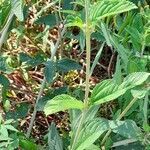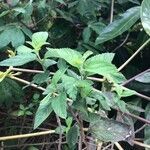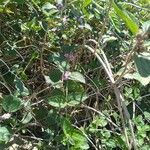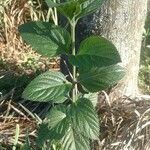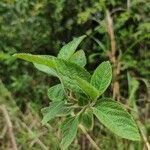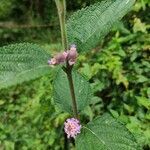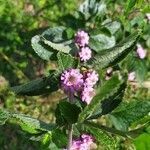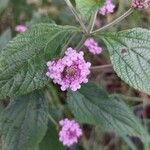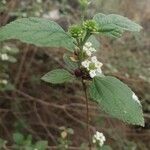Erect perennial herbs or straggly, aromatic, densely puberulent, low, coarse, erect shrubs or subshrubs, to 2 m tall, with a strong odor of lemon, lime, mint, or sage, sometimes scrambling, procumbent, or semi-procumbent, or more or less decumbent, rarely creeping or scandent, usually much-branched from the base and with long rooting basal suckers; stems many, to 1.5 cm in diameter, rooting at the nodes; branches elongate, slender, ascending or pendulous, sometimes arching, trailing, or prostrate. Leaves decussate-opposite or ternate, thickish, aromatic, the blades ovate or oblong, 2-7 cm long and usually 1.2-2.3 cm wide, dark-green above, acute or obtuse apically, conspicuously serrate or, serrulate along the margins (except at the very base), mostly cuneate or narrowed into the petiole basally, strigose-hirtellous or puberulent and more or less rugose (when mature) above, densely short-pubescent or soft-velvety to tomentose beneath with cinereous trichomes; petioles slender, 3-8 mm long, cinereous-pubescent. Inflores-cences axillary, capitate, usually much shorter than the subtending leaves or only subequaling the petioles, solitary or rarely paired in all the upper leaf-axils; heads globose or subglobose to shortly oblong, 8-12 mm long and ca. 8 mm in diameter; peduncles slender; bractlets ovate, 3-5 mm long, acute apically, the lowermost 3-3.5 mm wide, nearly as long as the corolla, not accrescent. Flowvers fragrant or non-odoriferous; calyx ca. 1/3 as long as the corolla, 2-toothed; corolla hypocrateri-form, in various shades of blue, pink, lilac, violet, lavender, mauve, or purple, sometimes white, often yellowish on the inner surface, the tube 4-S mm long. 2n = 40 (42?).
More
Shrub, procumbent-straggling, aromatic, 0.5–2.5 m high. Stem 5–15 mm diam., strigose, glandular. Leaves opposite, rarely in whorls of 3, petiolate, ovate to elliptic or almost orbicular, 15–45 mm long, 10–35 mm wide, rugose, hirsute, with intermixed glands on abaxial surface. Inflorescence capitate or subcapitate spikes, 5–12 mm long, 4–8 mm diam.; peduncle 7–20 mm long. Flowers sessile; bracts rotund to ovate, herbaceous, hispid and glandular outside, 3–5 mm long, 3–3.5 mm wide. Calyx somewhat compressed, not ribbed, 1.5–2 mm long, 2-lobed, membranous, pilose and glandular outside. Corolla hypocrateriform, pink-purple or lilac-mauve; tube cylindrical, 4–5 mm long; dilated upwards. Stamens included; anthers globose. Ovary glabrous, 0.5–1.5 mm long; style 1–2 mm long. Fruit subglobose, glabrous.
A shrub. It is branched. It grows 1.5 m tall. The leaves are opposite or in threes. The leaves are 1-3 cm long and 1-2 cm wide. The flowers are white or pink. They are in spikes 2 cm long
